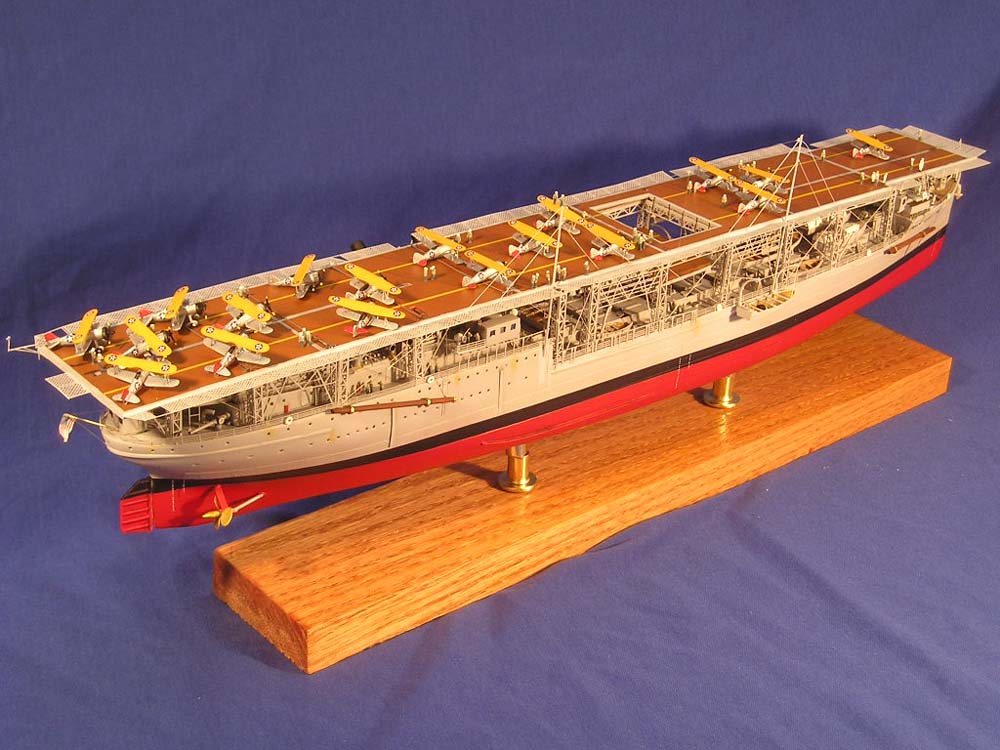by Peter Van Buren

1/350 USS Langley CV-1 (ISW)

The Iron Shipwrights (ISW) CV-1 USS Langley in 1/350 resin builds into a handsome and unique ship, but not without a fair amount of effort on the builder's part. Maybe I am spoiled by the current generation of resin kits, but my Langley had more than its share of voids and pin holes to fill on the hull. Every additional resin part required repair work due to the quality of the casting- please see the attached photos.
I personally found the airwing unusable and substituted Trumpeter aircraft (the kit included decals for only six aircraft anyway). The hull has no bilge keels molded on and these must be added by the builder (Ron Smith did a much better job of it than I did, please see his Langley )
Some defects, such as the out-of-line portholes, are just hard to accept (see this or this).
ISW includes multiple instances of most resin parts, I guess allowing you to pick and choose among them to find the one in best shape to repair. They also do liberally promote their no questions asked parts replacement policy but, given that I already had multiple instances of most parts in hand that ISW saw fit to ship out, I never bothered to ask for more. I might suggest more quality control to eliminate the need to send out multiple instances; one good set is sufficient.
ISW's resin parts seem to use a more aggressive mold release agent than some other makers'. I washed the parts in dish soap, scrubbing with an old toothbrush, then cleaned them with nasty tire blackwall foamy cleaner, washed again, primed with a fairly "hot" Krylon primer and I still had problems with paint lifting off under Tamiya's soft masking tape.
The instructions that come with the kit are rudimentary at best. There are cryptic notes telling you that some photoetch parts shown in the drawings are to be replaced with newer parts (which I could not get to align). Other than as a very general guide I did not find the instructions very helpful. The instructions appear to have you line up the trusses on the underside of the deck and then drop the whole thing onto the hull. I tried that but found it hard to have the trusses "land" on the right flat places on the deck. I ended up ripping the trusses off the underside of the deck and eye balling them into place on the hull, and then gluing the deck on top. My layout is not perfect accordingly.
The kit does not include any decals for the deck markings. One must mask and paint them. FYI, the deck is real wood and has significant non-scale grain lines running through it that need to be hidden under paint and stain. Care is needed in sealing and staining to avoid warpage.
I think the model turned out OK in the end, and certainly represents a unique ship that is otherwise unavailable in any other format. For that I guess it is fair to expect to "pay" a premium in terms of extra work. I remain a bit uncertain though how that is best played out; how much should we expect from a manufacturer and how much should the maker provide. This is not my first ISW kit, and while I have seen somewhat better quality in other purchases from them, many of the issues cited above seem to be part of their product line, at least within my experience.
Looking at the quality of casting and completeness of instructions from resin companies like JAG, Admiralty and many of the Eastern Europeans, it is clearly possible to produce very high quality castings, and draw complete instructions. The question I guess here is how low can you go if you have a unique model to offer. The other problem is that once one resin company makes a ship, the others seem to shy away from duplicating it. Competition can sometimes force a company's hand. The ISW Langley was not a cheap kit, listing for $400, so it will be up to the buyer to decide where the cost-benefit ratio plays out.
